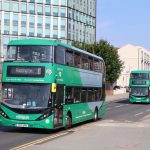Buses’ fortunes have been mixed over the last decade. The industry’s challenges will continue. But if it is to major on opportunities, success remains well within its grasp – if it is able to step up and grasp it
Early hints of what may be central parts of the long-awaited Bus Strategy that is being compiled by the Confederation of Passenger Transport (CPT) were dropped last week as CPT showed that it is ready to deliver on its better external engagement promise.
At an event attended by the national press, Chief Executive Graham Vidler and President Martin Dean presented the case for the bus, and what they believe its future holds.
Before moving to the latter point – with Martin also speaking in his capacity as Managing Director, Bus Development at the Go-Ahead Group – they ran through some figures that demonstrate both the challenges and the opportunities facing the industry.
National institution
Buses in Britain cover 1.2bn miles per year, but the mileage undertaken on tendered services outside London has halved since 2010. Even so, one in four people use a bus at least once per week, and over 2.5m use the mode to commute daily.
Nevertheless, 202m annual passenger journeys were lost between 2011/12 and 2016/17. The biggest driver for that has been extended journey times. Rising fares, online shopping and flexible working are among other factors.
Congestion and fares are linked, says Graham. Even a negligible reduction in commercial speed can result in a double-figure percentage costs increase if the frequency is to be maintained.
“That places upward pressure on fares. Operators face a difficult choice: Add buses and pass increased costs on to customers or reduce frequency and reduce the service’s attractiveness.”
Aspirations from some parties for London-style regulated bus networks have received scrutiny in CPT’s evidence gathering. While the capital’s £1.50 single fare is indeed cheaper than the minimums seen elsewhere, the reality for daily and weekly caps is different. Both are often cheaper in the provinces, despite much lower subsidy.

Game of two halves
Although passenger numbers overall have declined, there is wild variation between locations. Statistics show that between 2009/10 and 2017/18, Bristol was by far the best-performing area. It saw growth of around 50%.
At the other extreme are Rutland, Warrington and Stoke-on-Trent. Rutland saw patronage disappear almost entirely thanks largely to the end of subsidy. The other two locations witnessed drops of over 30%. Many other areas saw slumps of 20% or more.
Areas where partnerships have been developed generally performed best. Besides Bristol, Milton Keynes, Brighton and Hove, Southampton and Cornwall have all seen strong patronage gains.
Merseyside and the West Midlands saw net losses, but the partnerships there are younger. There are signs in each that the tide has been turned and that growth is now occurring.
What will concern operators in the north of England is that there is a distinct divide between buses’ fortunes there and in the south of the country. Of those areas that have seen a rise in patronage, all are in the latter.
Despite overall falling numbers, passenger satisfaction remains high. Even the rating for journey time is 85%. Moreover, bus beats rail in every category that is measured. Where approval is lowest is value for money.
What of the future?
The industry has lots to consider as it approaches the 2020s. While challenges are among them, there are also opportunities. Many of the latter are built around data.
The next decade will likely be when the high street either dies completely or reinvents itself as a more leisure-oriented destination. The fortunes of buses will be directly related to what transpires; they are also tied to flexible working and less focus on the five-day week.
“Maintaining our customer base is something we will have to think harder about,” says Martin. Currently, shopping trips account for 25-30% of bus patronage, but that is under pressure. In Gateshead, the Intu Metrocentre has seen reduced footfall, for example.
“But there are grounds for real optimism,” he continues. “Technology is developing rapidly. That will allow us to give customers the same choice as if they had a car.”
Doing do will be a necessity for success. Consumer expectations for seamless connections are rising, but app-based journey planning using multiple modes is also maturing. Individual car ownership is reducing, which is a further factor.
Data will also allow modifications to how services are delivered. Martin’s view is that within the next 15 years, it is likely that timetables will come to be tweaked as often as daily to reflect conditions, such will be the volume of data available. “It’s about the ability to analyse that. If we can understand it better, we can remove unnecessary journeys.”
Data and multi-modal opportunities may allow the industry to counter Uber and other taxi models. They have increased congestion and their vehicles delay traffic by stopping in prohibited areas.
In conclusion, it’s a mixed message for buses. But there is some light at the end of the tunnel. CPT’s Bus Strategy remains on target for release in September, ahead of Coach & Bus UK. Its Coach Strategy will follow.

























